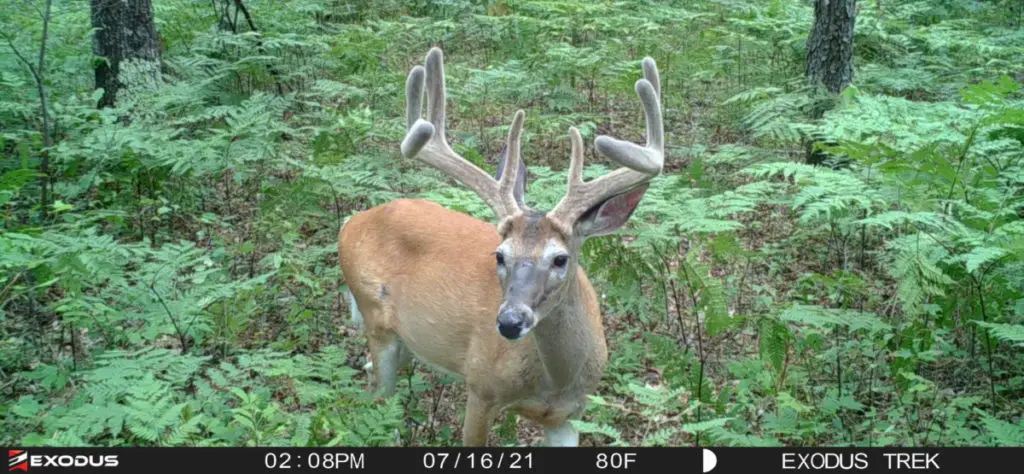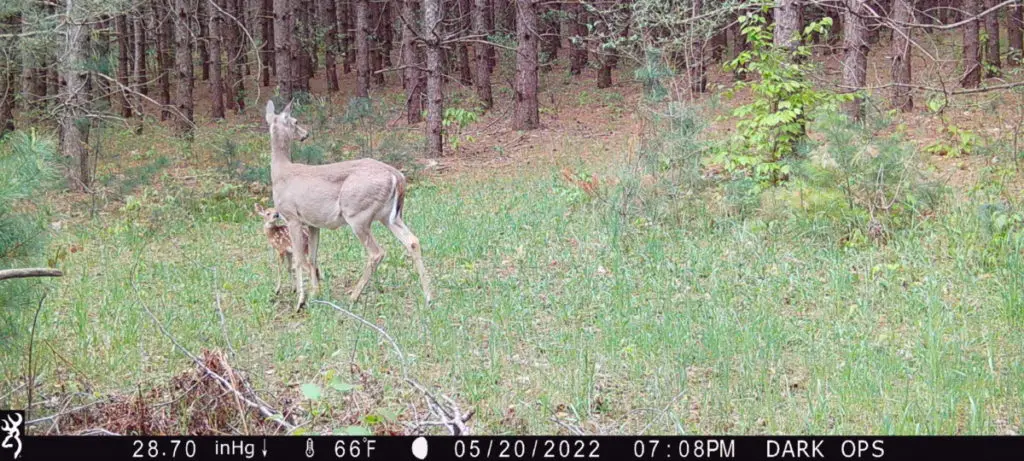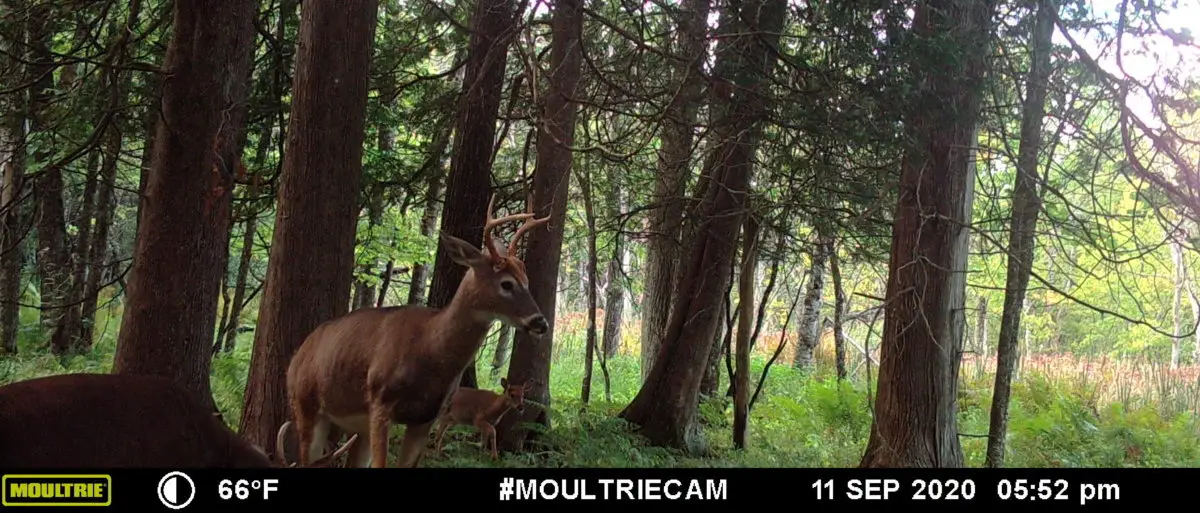At the end of every hunting season I bring in all of my trail cameras, and perform routine maintenance. I clean them up, check seals, place rubbing alcohol on the battery ports, and most importantly update firmware. With most of my trail cameras inside during most of the harsher winter months, the question often is when is the best time to put them back out into the field?
The best time to place trail cameras out in the field is by the end of May. There is a lot of information you can learn from early summer trail camera photos, such as inventory of bucks in the area, historical patterns, and the exact week fawns are born.
Lets break down some of my Summer trail camera strategies, to give you a better idea of the importance of getting your cameras out early.
Benefits of Placing Cameras out in May
I often hear the argument against placing your trail cameras out in the month of May. Most of those arguments are along the lines of wasting batteries, not finding any solid information from summer movements, and the lack of antler growth.
The truth is that when you look deep into why we run trail cameras, and how any information might benefit us long term, those small arguments turn out to not be true at all. I find, that especially when running traditional trail cameras, the benefit of placing them out early, has drastic impact on the hunting season in the fall.
Avoiding Hot Weather
When placing trail cameras in early summer, you often have the ability to get out before the hot weather hits. This allows you to take your time, pick the right locations of your camera, and enjoy your time in the woods.
Getting your cameras out by the end of May also allows you to avoid a lot of unwanted issues such as walking through tall grass and fighting off mosquitoes and ticks. Getting out before the full green up allows you to not only to move through the woods more comfortably, but it gives you a better visual on tracks, runways, and historical deer sign.
Bucks in the Area

A lot of people have given me push back on using trail cameras in early summer to gain an inventory of bucks. The basic claim is that bucks in general have different summer patterns than they do fall and winter patterns. The bucks that you get on trail camera in the summer will all but surely be long gone by hunting season.
While I do not dispute this thought process, deer in general will change patterns throughout the year, depending on food, pressure, available cover, and rut phases. However, the average home range of a mature buck begins to shrink as they age, and can be as small as a square mile. Having first hand knowledge of a buck within a square mile can instantly shrink your focus come hunting season.
Even in the worst case scenario, you have a buck that has moved 5 miles out of the area, it is still a strong starting point to begin to dissect some of the best bedding in the area, in search for a particular deer. I have never heard a single hunter say, “don’t waste your time glassing fields in the summer.” Why? Because it gives you a general idea of the quality of deer in the neighborhood, which is the same information you receive from running trail cameras.
Fawn Drop Times

One of the most overlooked factors of running trail cameras during the early summer months is getting a solid estimate of when Does begin to give birth to fawns. Yes, it is fun to get photos of the cute spotted fur balls, but the real reason is when you begin to see photos of fawns on your trail camera, you can estimate when the doe was bread.
A fawns gestation period is roughly 200 days from conception. Knowing this, will give you a very solid estimate as to when that particular doe had gone into heat. The significance of knowing the exact time this occurs is the difference between planning your rut hunting vacation a week too early or too late. Knowing the exact week bucks will be around to breed does is a powerful advantage come hunting season.
Doe Patterns
A lot of people often overlook patterning does, simply because its just not as fun as finding that big buck on your property, but knowing where does like to bed, when they move, where they eat and how they use the landscape can have incredible impacts on your hunting success in the fall.
At this point we already know within a week’s time of when does will go into estrus, and using trail cameras throughout the summer, we can glean a general movement pattern that doe family groups like to use. Having a solid knowledge of these two factors can help make hunting the rut in the fall more dynamic.
Velvet Growth
It goes without saying that the best part of running trail cameras during the summer, from an enjoyment perspective, is to watch the growth of velvet. Setting cameras out during May, gives you the ability to track velvet growth from the very beginning, and gives you a unique perspective of how remarkable the speed of velvet growth really is.
Historical Data
When we typically think about historical data, we often immediately go to the hunting season, and begin to pick apart when and why each deer was in an area. Sometimes its wind direction others times its food sources, but regardless of the reason we often try to find the exact reasoning for a buck’s intentions.
One thing that I have begun to find is that when you get a buck on camera during the early summer months, that same buck will often circle back into the immediate area at least once either before during or after the rut. Each buck is different, and each circumstance is different, however, I have been following a buck for a couple of years now, and I often get him showing up really early in May, and staying through June, but then disappearing.
To my surprise, historical data has shown that the same deer shows up again right before the rut kicks off in mid to late October. This is a deer that has otherwise “disappeared” from the landscape, but for what ever reason, shows up to his summer location like clockwork every year right before the rut. Having that type of historical information is gold, when it comes to patterning deer.
When To Check Trail Cameras
Much like applying fertilizer to my lawn, I follow a strict holiday policy for running trail cameras.
- Memorial Day – I set all of my cameras out by Memorial Day (end of May). This allows me to get information on when fawns will be dropped, and this time period is when there begins to be recognizable antler growth in bucks.
- 4th of July- I check cameras for the first time around July 4th. This will give me the ability to make sure all the cameras have been working over the past 6 weeks, and it also gives me the ability to remove and grass, leaves or branches that may have grown around the camera. It is also a great time to start mock scrapes if you use that tactic.
- Labor Day- Labor day weekend (first weekend in September) is the the last time I check cameras before hunting season. This is when I change all alkaline batteries out and replace them with Lithium batteries. This ensures that I will have plenty of battery power to last me through the hunting season and into the cold weather months.
- New Years- Typically after New Years I will take most of my trail cameras out of the field. This is a good time to update firmware and clean up cameras. With that being said, there are a few cameras I have that like the Spartan Lumen, that are white flash cameras, that take fantastic photos, that I put out after the season.

